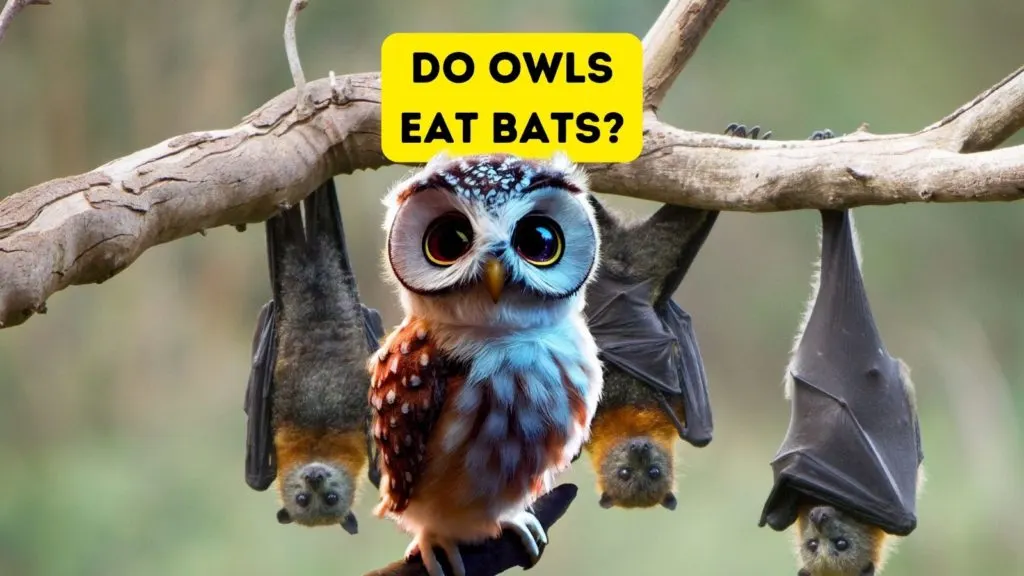In the intriguing world of nocturnal wildlife, the interaction between owls and bats presents a fascinating study. Many people wonder whether owls, as predatory birds, include bats in their diet. The answer is yes, certain owl species do prey on bats. Let’s see which owls are most likely to eat bats–and how they do so in the dark of night!

Which Owls Eat Bats?
Larger and more generalized owl species as well as specialized low-level hunters might include bats on their dinner menu. None of these owls feeds primarily on bats, instead choosing easier prey, but they do eat bats on occasion:
- Great Horned Owl – One of the largest owl species, capable of taking adult bats. Bats make up a small part of their diverse diet.
- Barred Owl – An opportunistic hunter that has been observed catching bats in flight or extracting them from crevices.
- Spotted Owl – Has been documented eating bats in parts of its range, taking advantage of bat colonies in tree cavities.
- Long-eared Owl – A stealthy hunter of dusk and dawn that catches bats on the wing near woodlands and wetlands.
- Short-eared Owl – Another specialist low-level hunter well-adapted for capturing bats in flight near open habitats.
- Northern Saw-whet Owl – Small but ferocious, known to prey heavily on bats in some forested areas.
- Flammulated Owl – Insectivorous but will opportunistically eat small bats.
- Barn Owl – An adept aerial hunter that regularly incorporates bats into its diet throughout North America.
Which Bat Species Do Owls Prey On?
In the United States, there are several bat species that could potentially become prey for owls. These include:
Little Brown Bat: A common bat species found across much of North America.
Big Brown Bat: Larger than the little brown bat, it’s also widespread in the U.S.
Eastern Red Bat: Known for its reddish fur, it’s a common bat in eastern states.
Mexican Free-tailed Bat: Found in the southern and western U.S., it’s known for roosting in large colonies. These are the bats we see around our home. Austin is home to the world’s largest urban bat colony, all Mexican Free-Tailed Bats–as well as plenty of owls–so we can safely say that while owls may be eating the occasional bat, there are still lots of bats!
Owls that are adept at catching bats often hunt them in areas where bats are abundant, such as near caves, under bridges, or in forests where bats roost.
Are Bats Difficult for Owls to Catch?
Bats can be challenging prey for owls to catch due to a few factors:
Agility – Bats are highly maneuverable in flight and can change direction quickly. This makes them harder to intercept compared to less agile prey. I always think bats look like huge butterflies when I see them–they flit around far different than birds do.
Echolocation – Bats use echolocation to navigate and detect predators at close range. This gives them an awareness advantage over visually hunting owls. Even though owls fly nearly silently, which lets them catch prey like rabbits, that stealth isn’t helpful against echolocation!
Low light activity – Many bats are most active flying at night or in low light conditions. This can make them harder for owls to spot compared to daytime avian prey.
Size – Small microbat species may be quite diminutive, requiring swift and precise aerial skills by the owl to target.
However, owls do have some advantages when hunting bats:
Night vision – Most owls see well in low light and have visual adaptations for nocturnal hunting not possessed by bats. Owls have extraordinary night vision that allows them to hunt very effectively in low-light conditions.
Speed/maneuverability – Larger owl species can fly as fast as 30 mph and maneuver deftly, enabling them to intercept bats in some situations.
Hunting techniques – Owls like barn owls and long-eared owls specialize in low-level aerial hunting well-suited for bats near habitat features.
So while bats pose challenges, certain owl species are well-adapted flyers that can and do successfully prey on bats depending on local abundance. It’s a challenging capture but one they accomplish regularly.
While not a primary food source, bats do form a part of the diet for some owl species. This predation is a natural part of the nocturnal ecosystem, highlighting the diverse and dynamic food web in which these creatures exist. Understanding the relationship between owls and bats sheds light on the complexity of natural habitats and the importance of preserving these environments for the sustenance and survival of various wildlife species, including these fascinating nocturnal hunters.
More Posts You Might Like
- 8 Letter Bird Names - August 14, 2024
- 7 Letter Bird Names - August 14, 2024
- 7 Birds Named After Famous People - July 23, 2024
